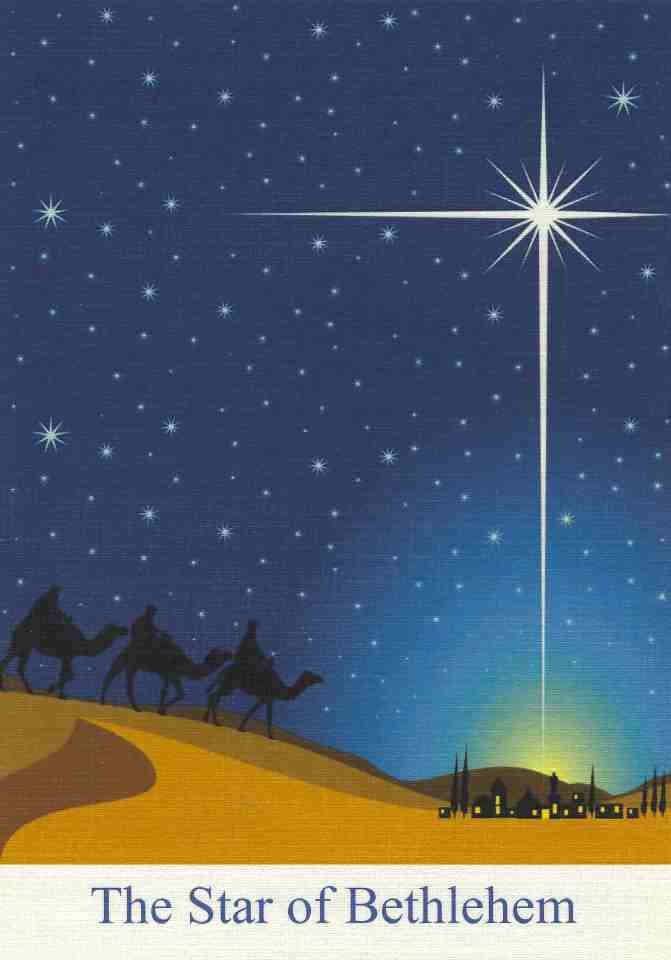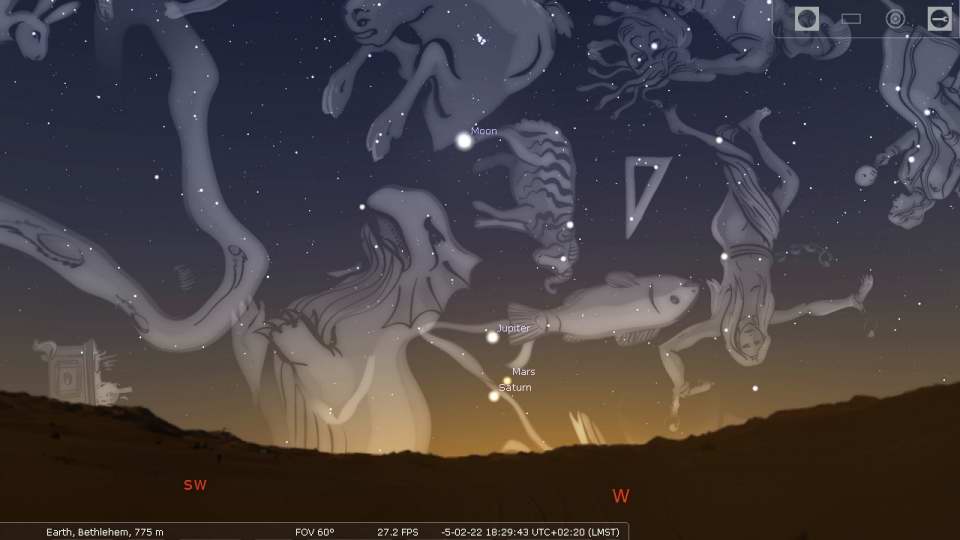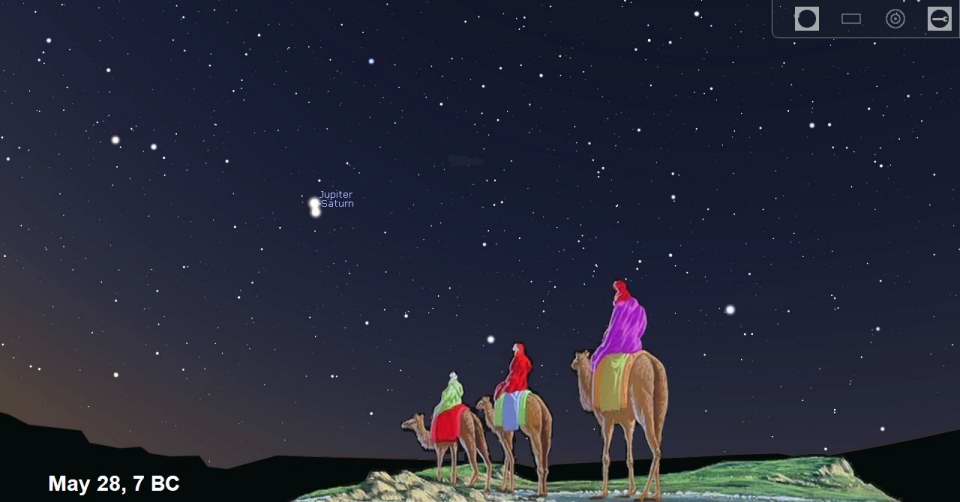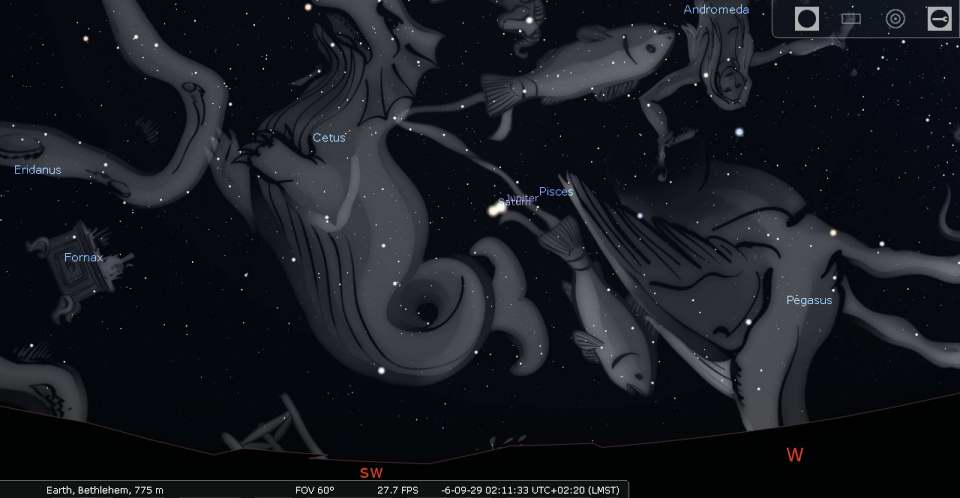The Star of Bethlehem
Can the Star of Bethlehem be explained astronomically?
L.E. Armfield - 1958
 At first glance it would seem easy to review the astronomical records and determine what celestial events took place at the time
of the birth of Christ. Factually, however, we do not know accurately when the birth of Christ occurred. Judea was under Roman
rule when Christ was born, and consequently the Roman calendar was in use in Palestine. The Roman years were counted from the
legendary founding of the city of Rome AB Urbe Condita, or AUC (from the founding of the city). The idea of counting the years from the
birth of Christ was not introduced until 533 AD by Denys the Little, a theologian and an astronomer. Denys studied the records available
to him and found a statement by Clement of Alexandria that the birth of Christ occurred in the 28th year of the reign of the Roman emperor
Augustus. Denys found that Augustus was proclaimed emperor in the year 726 from the founding of the city of Rome. Denys added 28 years to 726
to obtain the year 754 from the founding of the city as the year of the birth of Christ, which he established as the year 1 AD. Denys
apparently was not aware of the fact that Augustus had ruled Rome for a period of four years following the death of Caesar in 44 BC under
his own name of Octavian. The title of Augustus was not conferred upon Octavian by the Roman Senate until four years after the death of Caesar.
Thus Denys inadvertently introduced an error of four years in the establishment of the year 1 AD.
At first glance it would seem easy to review the astronomical records and determine what celestial events took place at the time
of the birth of Christ. Factually, however, we do not know accurately when the birth of Christ occurred. Judea was under Roman
rule when Christ was born, and consequently the Roman calendar was in use in Palestine. The Roman years were counted from the
legendary founding of the city of Rome AB Urbe Condita, or AUC (from the founding of the city). The idea of counting the years from the
birth of Christ was not introduced until 533 AD by Denys the Little, a theologian and an astronomer. Denys studied the records available
to him and found a statement by Clement of Alexandria that the birth of Christ occurred in the 28th year of the reign of the Roman emperor
Augustus. Denys found that Augustus was proclaimed emperor in the year 726 from the founding of the city of Rome. Denys added 28 years to 726
to obtain the year 754 from the founding of the city as the year of the birth of Christ, which he established as the year 1 AD. Denys
apparently was not aware of the fact that Augustus had ruled Rome for a period of four years following the death of Caesar in 44 BC under
his own name of Octavian. The title of Augustus was not conferred upon Octavian by the Roman Senate until four years after the death of Caesar.
Thus Denys inadvertently introduced an error of four years in the establishment of the year 1 AD.
What other evidence is there concerning the time of Christ's birth? In Matthew 2:1 we find the statement that "Jesus was born ... in the days of Herod the King." The historian Josephus tells us that Herod died a few days after an eclipse of the moon visible from Jericho and a few days before the feast of the Passover. Since the dates of eclipses and of Passover depend on the moon's motion, it is possible to determine such dates accurately by calculation. The only lunar eclipse which satisfies the conditions necessary occurred on March 13, 4 BC. The Passover was celebrated on April 12, 4 BC. Herod, therefore, must have died near April 1, 4 BC, and Christ must have been born prior to this date; possibly two or three years before 4 BC.
Another clue is found in Luke 2:1-5
Now, if we knew just when this tax collection took place, the birth date of Christ would be known. Unfortunately, no exact
record was kept and no one had an accurate idea thereof, until approximately twenty years ago, when some archeologists working in Ankara,
Turkey, uncovered an inscription giving a list of the years in which orders were issued for tax collections. Of the several orders listed,
three were issued during the period we are interested in, 28 BC, 8 BC, and 14 AD. It is obvious that 28 BC is too early and 14 AD is too late,
consequently, the one issued in 8 BC apparently is the order which occasioned Mary and Joseph to proceed from Galilee out of the
City of Nazareth to Bethlehem. Thus, it appears that the birth of Jesus may have occurred as early as 8 BC. It must be remembered, however,
that travel and communication were slow in those days and it is logical to deduce that the orders for tax collection in Palestine may have
been delayed for a year or more as Palestine was near the outer edges of the Roman Empire. It is conceivable, therefore, that Christ
may have been born in 7 BC or even 6 BC. Another clue is again found in Matthew 2:1-8
It will be noted that Herod called the wise men and inquired of them "diligently" what time the star appeared, so apparently, the star was not seen by Herod or the people of Palestine, nor had it been called to his attention prior to the visit of the wise men. Obviously, then, the star seen by the wise men could not have been spectacular in appearance, for any brilliant object in the sky would have been called to Herod's attention. Therefore, the star must have been rather commonplace and not noticed by the people, but nevertheless of special significance to the wise men which occasioned them to start on their long journey to Palestine. Who were the wise men? Where did they come from?
We know from Matthew they came from the East and further research indicates they probably came from Persia, now called Iran, and as they were called Maji, it is very likely they were priests of the Zorastor religion. As such, they practiced astrology which was a very important part of their religion. They believed the heavenly bodies influenced the lives of individuals as well as nations. They had developed a very complex procedure by which it was supposed that this influence could be determined in advance of its occurrence. They had divided the sky into various imaginary regions which they called houses. These regions were supposed to control various parts of the earth, various races of people and different parts of the body. The influence of the several regions was supposed to be determined partly by the arrangement within them of the seven ancient members of the solar system namely; Mercury, Venus, Mars, Jupiter, Saturn, Earth and Sun. The planets move about and change their positions among the stars due to their revolution around the sun. In the practice of astrology any unusual arrangement of them was a portend of some unusual event. The priests of Zoroaster (the wise men) were familiar with the ancient prophecies concerning the coming of a King of the Jews whose birth was to be preceded by a sign in the sky as prophesied in Numbers 24:17, A STAR SHALL RISE OUT OF JACOB. In fact, since astrology was part of the religion of Zoroaster and naturally the wise men would be watching the planets in the heavens for such a sign. The constellation Pisces had been named by them as THE HOUSE OF THE HEBREWS and the movement and arrangement of the planets within Pisces was supposed to control the destiny of the Hebrew race. Likewise, the planet Saturn also was supposed to influence the Hebrew race, especially when Saturn appeared in the constellation Pisces THE HOUSE OF THE HEBREWS.
With this background we find another clue as to the birth date of Christ by an event which occurred in early October in 1604. Kepler, one of the greatest of all astronomers, while observing a close grouping of the planets, Mars, Jupiter and Saturn, saw a bright Nova (new star) appear in their midst. This is something of a miracle in itself, in that Kepler of all people, an astronomer, should see a Nova appear at the very moment he was watching the planets. It was such a striking sight that it caused Kepler, a deeply religious man, to think of the Star of Bethlehem. Kepler made calculations to see when this close grouping of Mars, Jupiter and Saturn had occurred in prior times. Kepler's calculations revealed that such grouping happens once each 805 years and thus the three planets were closely grouped in the constellation of Pisces, THE HOUSE OF THE HEBREWS, early in the year 6 BC.
 Screen shot from Stellarium.
The sky as seen from Bethlehem looking west showing the conjunction of
Jupiter, Saturn, and Mars on February 22, 6 BC in the constellation Pisces.
Screen shot from Stellarium.
The sky as seen from Bethlehem looking west showing the conjunction of
Jupiter, Saturn, and Mars on February 22, 6 BC in the constellation Pisces.
 Screen shot from Stellarium of the 2nd of 3 conjunctions of Jupiter and Saturn during the year 7 BC.
Screen shot from Stellarium of the 2nd of 3 conjunctions of Jupiter and Saturn during the year 7 BC.
Furthermore, he found that in the spring of 6 BC, after Mars had moved away from Saturn and Jupiter, but while the latter two were quite close together, Venus, the brightest of the planets, passed Jupiter and Saturn forming another close and unusual grouping which was visible in the morning sky in Pisces, THE HOUSE OF THE HEBREWS. The next such grouping will occur in the year 2409.
- When they had heard the king, they departed; and lo, the star, which they saw in the east, went before them, till it came and stood over where the young child was.
- When they saw the star, they rejoiced with exceeding joy.
These deductions tend to explain also, the apparent discrepancy between the wise men finding Jesus in a house and the shepherds finding Jesus in a manger as accounted by Matthew 2:11 and Luke 2:16.
Matthew 2:11 And when they were come into the house, they saw the young child with Mary his mother, and fell down, and worshiped him: and when they had opened their treasures, they presented unto him gifts; gold, and frankincense and myrrh.
Luke 2:16 And they came with haste, and found Mary, and Joseph and the babe lying in a manger.
You will note also in Luke 2:8-9, the shepherds saw an angel of the Lord and not the star.
Luke 2:8-9
It is obvious to conclude, therefore, that the shepherds found the Christ child in the manger on the night of His birth while the wise men arrived before the child sometime after the Shepherds. How many days after his birth is the puzzling question? In Leviticus 12:1-6 Moses established a requirement of purification for women giving birth to a male child.
- And the Lord spake unto Moses, saying
- Speak unto the children of Israel saying, If a woman have conceived seed, and born a man child: then she shall be unclean for seven days; according to the days of the separation for her infirmity.
- And in the eighth day the flesh of his foreskin shall be circumcised.
- And she shall then continue in the blood of her purifying three and thirty days: she shall touch no hallowed thing, nor come into the sanctuary, until the days of her purifying be fulfilled.
- But if she bear a male child, then she shall be unclean two weeks as in her separation: and she shall continue in the blood of her purifying three score and six days.
- And when the days of her purifying are fulfilled, for a son, or for a daughter, she shall bring a lamb of the first year for a burnt offering, and a young pigeon, or a turtledove, for a sin offering, unto the door of the tabernacle of the congregation, unto the priest:
This requirement for a male child involved a period of 41 days before a woman is required to bring an offering to the door of the temple. It appears logical, therefore, to deduce that Mary, following the birth of Christ and laying him in a manger, fulfilled her period of purification according to the law. She then journeyed with Joseph to the temple in Jerusalem; made her offering and returned to Bethlehem. The collection of taxes having been completed during the forty-one day period of purification, the city of Bethlehem returned to normal and upon their return from Jerusalem, space was available, in a house for Mary, Joseph and the child. Thus, the wise men arrived and found the child in a house, so we see that a discrepancy does not exist between Matthew and Luke, but simply a discrepancy in the time between two separate events described by the two different authors.
Now, let us lay deductions aside and return to possible astronomical explanations for the Star of Bethlehem.
First, was it a brilliant METEOR? This we must discard; as a meteor is much too transitory, lasting only a few seconds.
Second, was it a COMET? The records of comets are quite complete and always have attracted wide attention. The records reveal Halley's comet appeared in 11 BC and another bright comet appeared in 4 BC. Neither coincides with our established date of 6 BC. It appears, therefore, that a comet does not satisfy the necessary conditions.
Third, was it a super NOVA? The records do not reveal a Nova appearing during the period in question. Records of Nova are not too complete, so the possibility of a Nova should not be discarded entirely, particularly in view of Kepler's beliefs.
Fourth, was it an unusual GROUPING OF THE PLANETS such as we have discussed previously? It is well to remember that the use of the word "star" in those days did not necessarily mean an individual point of light as we construe it today. The word "star" was used to signify a group of stars or a group of planets. Consequently, the close grouping of planets might well have been described as a star.
Fifth, Kepler's belief in an unusual grouping of the planets and the simultaneous appearance of a NOVA.
Sixth, a MIRACLE and, therefore, utterly inexplicable to us.
In the last analysis, the astronomical explanation of the STAR is not important. What is of much greater importance is the CHRISTMAS STORY itself, and the simple but everlasting truths which it represents and which forms the basic fabric of our rich Christian heritage. A baby was born, grew through childhood into maturity, dedicated his life to God, and as He said, "I and my Father are one." In the Garden of Gethsemane, He also said, "Father, if thou be willing, remove this cup from me, nevertheless, not my will but thine be done." His message to us and all mankind is clear, if we follow him in thought, word, deed and action, we too may become one with the Father by dedicating our lives to him, so that we may also say, "not my will but thine be done."
Addendum
The Star of Bethlehem by L. E. Armfield was originally published by Communications Consultants, Inc. In 1958, 1959, 1964, 1972, 1974. The last printing in 1977 had; "With great joy and renewed enthusiasm and the people of Communications Consultants, Inc. send you their greetings this Christmas Season of 1977. This year, perhaps more than ever, we receive strength and encouragement for the Christmas Story. For this reason we would like to share with you the faith our company's founder and leader had. The last paragraph of his scholarly work The Star of Bethlehem expresses that simple faith by which he lived.
Footnotes
This article is courtesy of Connie Stenhjem. She is the daughter of the author, Luverne Armfield, who founded the Milwaukee Astronomical Society in 1932. We have a biography of Armfield that you can read here on our website.
The planetarium screen shots from Stellarium were added to this article as this technology was not available to Armfield. However, we are confident that he would have and would therefore approve of its inclusion here.


